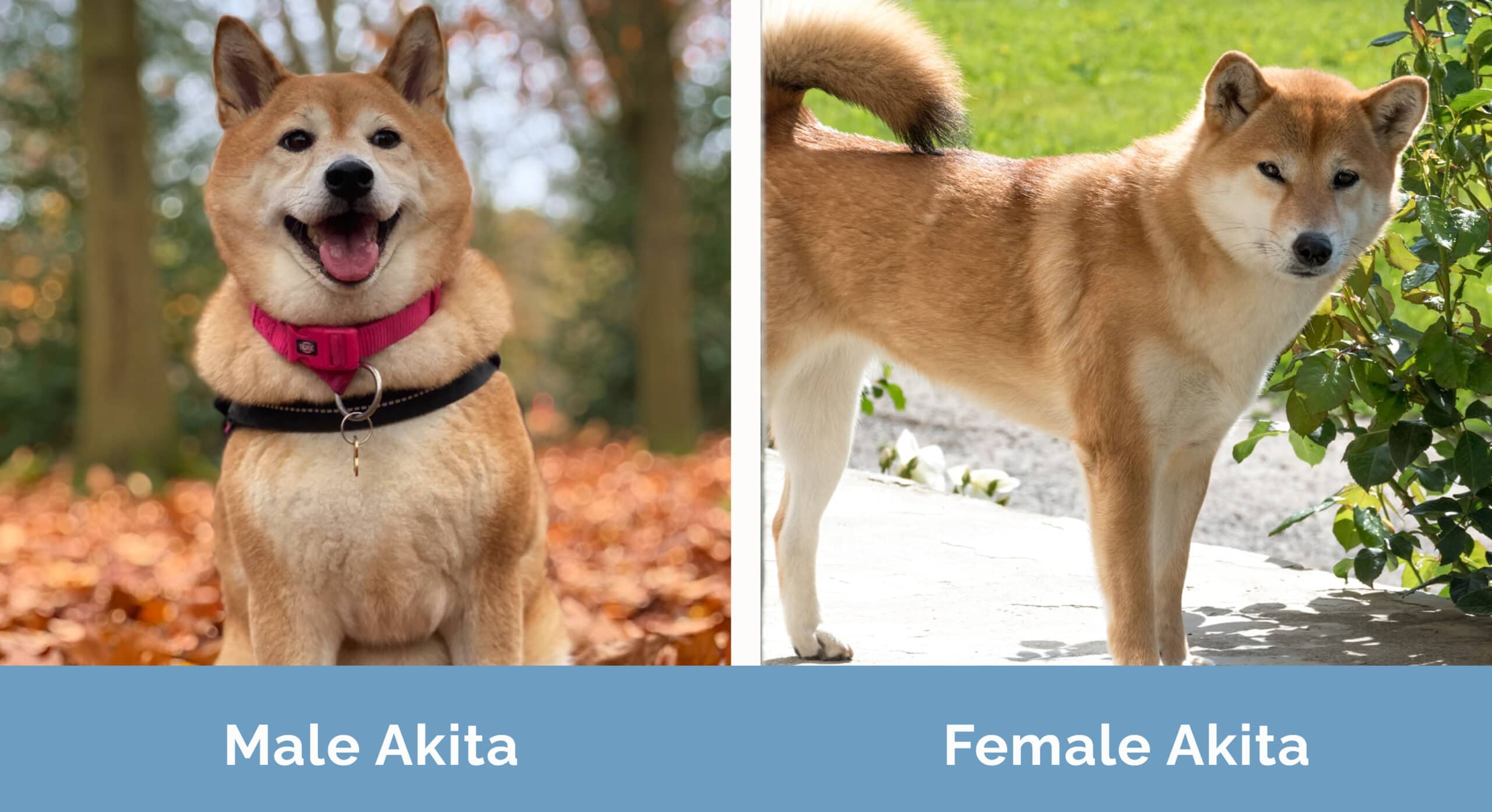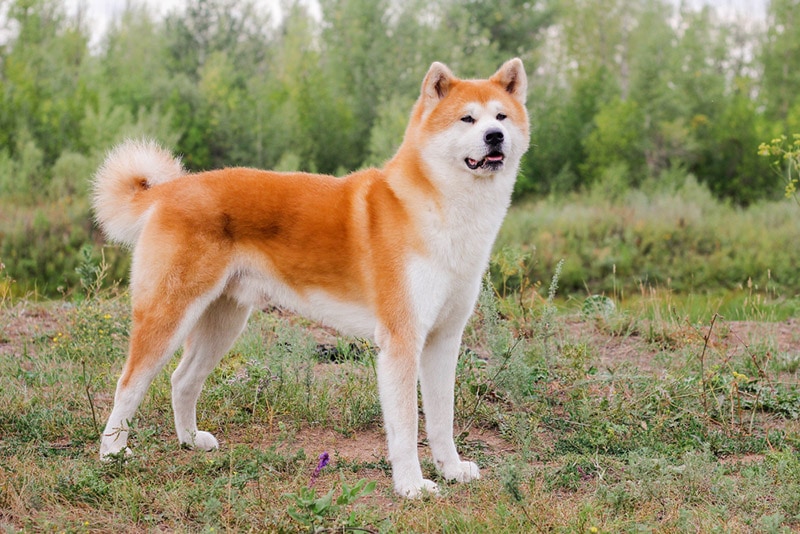Male vs Female Akita: Differences Explained (With Pictures)

Updated on

The Akita originates from Japan; they’re powerful, loyal, wary around strangers, and fun-loving with their owners. They were once used for protection and to hunt big game, and we know they’re fearless and won’t back down when challenged.
While you might know a little about this breed already, you may find yourself here in search of how the male and female Akitas differ from one another. Knowing these differences could help you narrow your search if you’re considering getting one of these beautiful dogs.
Visual Differences

At a Glance
- Average height (adult): 26–28 inches
- Average weight (adult): 100–130 pounds
- Average height (adult): 24–26 inches
- Average weight (adult): 70–100 pounds
Akita 101
The Akita are not for the faint of heart; they are a dignified breed symbol of long life, happiness, and good health. They have dense coats, broad heads, and curled-over tails. They’re fastidious and quiet, wary of strangers, and can be intolerant of other animals. On the flip side, they can be affectionate and silly with the humans they care about the most. They are protectors and thrive on human companionship.
Socialization as early as possible is crucial for this breed, but it won’t change who they are; while they will be tolerant of people, they will still not be the life and soul of the party. Instead, they are a dignified presence, always ready to protect their loved ones.
They can be incredibly stubborn and are better suited to a more experienced owner with the time and expertise to train them. They are dominating and will take on the role of the boss if you fail to set proper boundaries with them. Akitas are known for mouthing, which is where they like carrying things in their mouths. It could be objects or even your wrist, and it’s a form of communication—they might then lead you to their leash to let you know they’d like to go for a walk.
Male Akita Overview
Personality / Character
Male Akitas are known for being more social and slightly less suspicious of strangers than their female counterparts, so socializing them might take less effort. They are also more attention-seeking and more likely to bond with all family members. However, they are also more demanding of attention.
If you have children, they’re more likely to be found outside playing with them than the female would. Male Akitas are also known for being less neat and clean.

Training
Akitas are intelligent, but the males tend to be slightly more so. You would think this would make them easier to train. However, this intelligence comes with a more stubborn streak, so they can actually be quite tricky to train. Since training is crucial with this breed, this might change your opinion on the male; these dogs can weigh over 100 pounds, are powerful and muscular, and the owner should ideally be involved in the training because they’re so faithfully loyal to their humans.
Health & Care
Akitas are generally prone to some health problems, but males are more likely to suffer from bone, hip, and joint problems. Some issues like hip dysplasia and bloat are also linked to their size. They are prone to prostrate cancer, but their chances of getting this can be lessened with neutering, which you can discuss with your vet.
It can feel like you have less control over caring for your Akita regarding genetics and inherited diseases. However, this is why keeping up with your vet visits is so important. Many problems can be managed with the proper treatment and care.

Breeding
As we’ve mentioned, neutering can improve your dog’s health. However, it can also change their behavior. Neutering a male dog involves removing the testicles, which can cause subtle changes in behavior. Of course, all dogs are different, and there is some debate about how much neutering affects a male dog’s behavior. However, some agree that some behaviors can be linked to not neutering your dog, such as:
- Aggression
- Increased libido
- Increased self-confidence (increased risk-taking and reduced fear response)
- Roaming (looking for females in heat to mate with)
- Sexual behaviors (like humping and mounting objects/furniture)
- Territorial behavior
It’s advised that unless you’re planning to breed your Akita, it’s a good idea to neuter him. Generally, neutering is considered to be a relatively minor procedure and is cheaper in comparison to spaying a female.
- Sociable
- More playful with children
- More intelligent
- Neutering is cheaper than spaying
- Stubborn
- More difficult to train
- Less clean and neat
Female Akita Overview
Personality / Character
All Akitas are known to be loyal and protective, but females are particularly so, and they generally bond more with one member of the family than the whole unit. This might make them a slightly better choice for a single owner, especially one who doesn’t have many strangers around, because female Akitas are more suspicious of unknown humans than males. They are known to be less hyper during their puppy years, less playful, and slightly more serious.

Training
Female Akita are easier to train than their male counterparts; they are less stubborn, more focused, and eager to please, which is an excellent combination for training. They tend to do better off the leash because they aren’t as easily distracted as the males; however, just like the males, they can get bored easily, so it will be up to you to keep the enthusiasm for training up.
Health & Care
Females are less prone to the health problems plaguing their male counterparts. Still, they are prone to major diseases, like cancer, auto-immune diseases, sebaceous adenitis, glaucoma, hypothyroidism, and progressive retinal atrophy, which threaten both genders. It’s important to note that just because a breed is more likely to develop a health problem doesn’t mean they will get everything they’re vulnerable to.

Breeding
There are significant benefits to spaying your female Akita, which means you should consider getting her spayed before her first heat unless you’re planning to breed her. This typically occurs when a dog is 6 to 15 months old.
Not only does spaying prevent unwanted pregnancy, but it can also decrease the incidence of breast tumors and uterine infections.
- Particularly loyal and protective
- Less stubborn
- Will bond with one person in particular
- Easy to train
- Less playful
- Warier around strangers
Which Gender Is Right for You?
Male and female Akitas are incredibly similar, and picking which is right for your family is difficult. If you are unsure which one would work best, you’re in the right place.
An excellent place to start is the pros and cons lists, which will help you determine which gender fits best with your family dynamic. For example, male Akitas are more social and bond with a larger family unit, while females connect with one person. Males are also slightly more playful and less serious than females, so they might be better suited to a family with children, while a female will be perfect for a single owner.
Akitas, in general, require early socialization and training, so keep this fact in mind as you start a pros and cons list for your family. It’s clear, whatever gender you go for, this protective, regal dog will be an excellent addition to your home!
See also:
- How Does Cat Flea Medicine Work? Vet Approved Explanation
- Leather Back Bearded Dragons: Facts, Pictures, Habitat & Care Guide
Featured Image Credit: (L) Gabriel Yuji, Unsplash | (R) Brock Wegner, Unsplash













